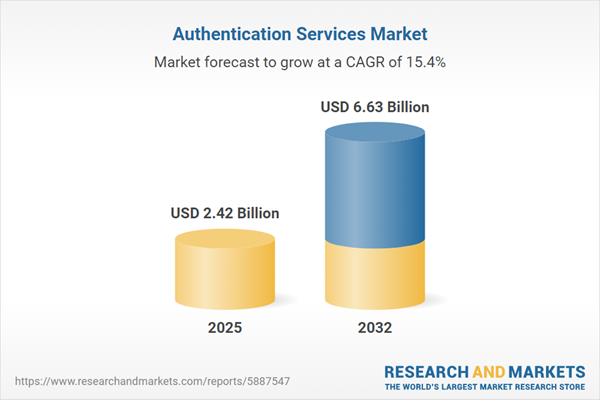Speak directly to the analyst to clarify any post sales queries you may have.
Authentication services have become a core pillar for enterprise security strategies, delivering essential digital trust and operational continuity in dynamic business environments. Senior leaders now recognize that robust authentication is crucial for secure and efficient access management across distributed teams and regulatory jurisdictions.
Market Snapshot: Authentication Services Market Growth Dynamics
The authentication services market is expanding rapidly, with a global valuation set to grow from USD 2.10 billion in 2024 to USD 2.42 billion by 2025 and projected to reach USD 6.63 billion by 2032. This strong compound annual growth rate (CAGR) of 15.41% is fueled by accelerated cloud computing adoption, increased deployment of Internet of Things (IoT) devices, and organizations’ rising concern for credential protection. Enterprises are prioritizing authentication services to achieve compliance and secure their assets, especially as cloud infrastructure expands and device endpoints multiply. As the market continues to evolve, enterprises are focusing on solutions that deliver both operational agility and regulatory transparency.
Scope & Segmentation in Authentication Services
- Authentication Types: Offerings span multi-factor, biometric, token-based, certificate, password-based, risk-driven, single sign-on, adaptive, and continuous authentication to address varying security needs across industries.
- Multi-factor Variants: Two-, three-, and four-factor authentication models combine elements such as biometrics, tokens, certificates, and passwords, ensuring sectoral compliance in verticals like finance, government, and healthcare.
- Biometric Modalities: Solutions employ facial, fingerprint, iris, and voice recognition for enhanced identity assurance, particularly vital in highly regulated environments where definitive verification is mandatory.
- Token Solutions: One-time passwords, physical tokens, and SMS or email-based options strengthen secure access for geographically dispersed teams within cloud-enabled settings.
- Certificate Solutions: Client certificates, digital signatures, and PKI approaches underpin security for both legacy and next-generation systems, supporting operational efficiency and regulatory alignment.
- Password Methods: Systems utilizing PINs, graphical, and text-based passwords reinforce layered cybersecurity approaches adaptable to organizations of all scales.
- Risk & Adaptive Features: Behavioral analytics, device identification, and risk scoring enable enterprises to modulate authentication based on threat levels and compliance drivers.
- Regions: Authentication practices adapt across the Americas, Europe, Middle East and Africa, and Asia-Pacific to accommodate local security mandates and privacy expectations.
- Key Countries: Regulatory leadership and adoption are shaped by nations including the United States, Canada, Brazil, United Kingdom, Germany, China, India, Australia, and South Africa, influencing global standards.
- Companies Profiled: Major vendors—Microsoft, Okta, Ping Identity, IBM, Cisco, RSA Security, Amazon Web Services, Google, ForgeRock, and CyberArk Software—deliver enterprise-grade authentication and compliance solutions across markets.
Key Takeaways for Senior Decision-Makers
- Advanced authentication measures reinforce digital asset security and streamline access for onsite, mobile, and hybrid employees, aligning with modern transformation goals.
- Passwordless and adaptive authentication reduce friction for users and adapt to emerging threats, supporting an efficient enterprise environment.
- Decentralized identity solutions and cloud-oriented authentication models provide flexible, scalable security, empowering organizations to remain agile without elevating risk.
- Dynamic authentication platforms equip organizations to nimbly adjust to evolving regulatory frameworks and simplify compliance as operational footprints expand.
- Engaging with established authentication providers helps standardize access and improve process consistency across international sites.
- Integrating with recognized security frameworks elevates identity governance and advances the organization’s broader risk management initiatives.
Tariff Impact: United States Tariffs on Authentication Supply Chains
New United States tariffs on components such as semiconductors, smartcards, and biometric devices are elevating the cost of physical authentication solutions. This shift is driving more organizations to seek software-based and cloud-native authentication, helping mitigate hardware supply risks and support uninterrupted operations. There is also rising interest in tariff exemptions, indicating a pivot toward adaptable security models responsive to regulatory and operational changes.
Authentication Services Market: Methodology & Data Sources
This market analysis integrates secondary research, regulatory documentation, and direct insights from security experts and industry practitioners. Utilizing these diverse sources ensures actionable guidance for leaders evaluating authentication technology investments and strategic direction.
Why This Report Matters
- Enables executives to align authentication strategies with organizational risk management and transformation projects while navigating evolving regulatory landscapes.
- Identifies leading technologies and vendor partnerships that facilitate compliance, security, and scalability across global industries.
- Assists IT and procurement teams in selecting future-ready authentication services tailored to existing and emerging needs.
Conclusion
Staying current with trends in authentication services allows organizations to reinforce security posture, adapt quickly to changing business needs, and address regulatory demands proactively.
Additional Product Information:
- Purchase of this report includes 1 year online access with quarterly updates.
- This report can be updated on request. Please contact our Customer Experience team using the Ask a Question widget on our website.
Table of Contents
3. Executive Summary
4. Market Overview
7. Cumulative Impact of Artificial Intelligence 2025
Companies Mentioned
The companies profiled in this Authentication Services market report include:- Microsoft Corporation
- Okta, Inc.
- Ping Identity Holding Corp.
- International Business Machines Corporation
- Cisco Systems, Inc.
- RSA Security LLC
- Amazon Web Services, Inc.
- Google LLC
- ForgeRock, Inc.
- CyberArk Software Ltd.
Table Information
| Report Attribute | Details |
|---|---|
| No. of Pages | 195 |
| Published | October 2025 |
| Forecast Period | 2025 - 2032 |
| Estimated Market Value ( USD | $ 2.42 Billion |
| Forecasted Market Value ( USD | $ 6.63 Billion |
| Compound Annual Growth Rate | 15.4% |
| Regions Covered | Global |
| No. of Companies Mentioned | 11 |









